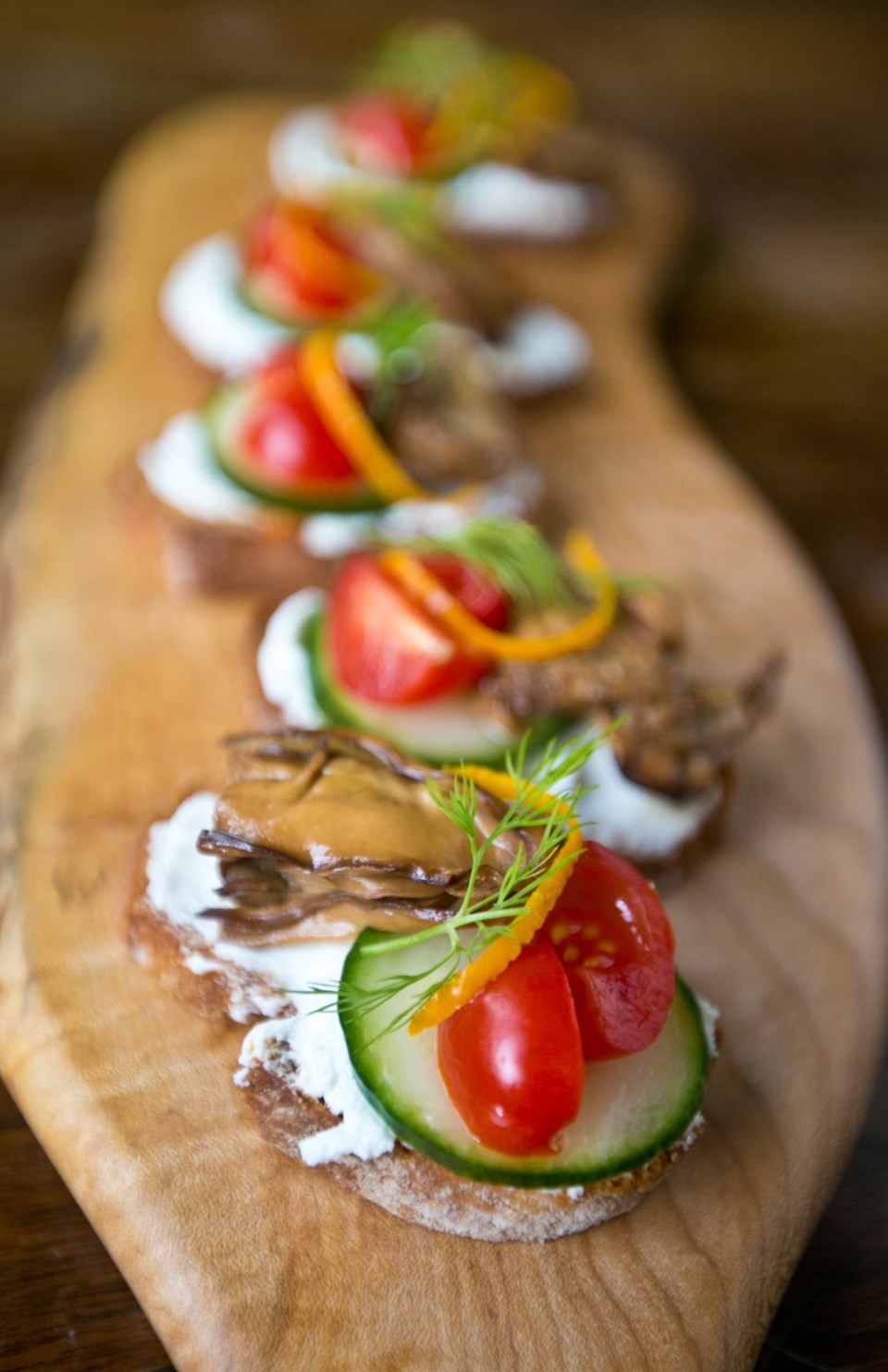 Every Christmas, I send gift packages to my two brothers and their families in Ontario. I always include fine local food products — things from B.C. they won’t find in stores where they live.
Every Christmas, I send gift packages to my two brothers and their families in Ontario. I always include fine local food products — things from B.C. they won’t find in stores where they live.
Among the gifts I send are cans of B.C. seafood, such as salmon, tuna and smoked oysters. They are products I love and love sharing, and I feel fortunate I’m still able to do it, given the state of the seafood canning business in our province these days.
In B.C. in the early 1900s, there were more than 100 canneries operating along our coast, employing locals and feeding Canadian and global demand for canned salmon. As the decades rolled along, though, technology increased efficiencies in canning techniques, and that led to a major consolidation of the seafood canning business in B.C. and internationally.
I say internationally because that’s where most of the canned seafood sold in B.C., including fish from our waters, is now processed, in places such as China and Alaska.
And even less fish will be canned in B.C. after last month’s decision by the Jim Pattison-owned Canadian Fishing Corporation to shut down its salmon-canning operations in Prince Rupert and have its product canned abroad.
That decision means there are now just two small production salmon canneries in Canada. They are Coastwise Fisheries in Langley and St. Jean’s Cannery & Smokehouse in Nanaimo.
“We are the larger [cannery], and also [Coastwise Fisheries] are predominantly a pet-food processor,” said Gerard St. Jean, president of St. Jean’s Cannery & Smokehouse.
That means there’s not a lot of choice for consumers wanting to buy B.C. canned salmon and other seafood. But the good news is that St. Jean’s is amazing at what it does and their products are as good as — I would say better than — you can get anywhere in the world.
St. Jean says the business model for giant commercial canneries is to pack large amounts of fish in a short time using machines. At St. Jean’s Cannery, he says, they take the opposite approach to make a premium product.
“Our model has been hand-packed and quality product, with a much smaller volume of fish,” said St. Jean.
St. Jean’s Cannery’s general manager, Steve Hughes, said they try to can all of their salmon products from fresh, locally caught fish and seafood.
“We have relationships with fishers and processors throughout B.C. and adjust our processing schedules so we can get the best product in the can as quickly as possible,” Hughes said.
For tuna, Hughes said they use West Coast Albacore tuna, which is quickly frozen on the fishing boat to maintain its just-caught quality.
“We work with boats and processors to secure the best tuna and then fillet and can throughout the year,” Hughes said. “As a smaller, hand-packed cannery, talented people are cutting and grading the fish at every step of the production.”
When he says hand-packed, he means after the raw fish is trimmed, a real person packs it into the can with a touch of sea salt and cooks it in the can, ensuring all its flavour and nutritional benefits remain there.
This process varies greatly from the way cans of imported tuna are prepared, where the tuna is cooked first in a commercial pressure cooker as whole loins, divided into portions, then canned and cooked again. During this process, moisture and natural oils from the fish are lost, which is why a liquid such as water or broth is added to that tuna before it is canned. That does not happen at St. Jean’s Cannery.
Beyond tuna and salmon, St. Jean’s also cans such things as clams, smoked fish, chowder and Pacific oysters.
St. Jean’s also co-packs for other companies wanting to have their seafood canned in B.C., and has for decades been the place where sports fishermen have their salmon canned or prepared in another way.
In Victoria, you can buy St. Jean’s products at some grocery stores, such as Peppers Food Store and Country Grocer. This December, St. Jean’s is operating a kiosk at Mayfair Mall, selling all its products and also gift packs and baskets. For other locations selling St. Jean’s products, including their retail store in Nanaimo, or to order their products online and have them shipped, go to their website at stjeans.com.
“We have shipped to almost every corner of Canada and throughout most of the United States. We also get orders occasionally from several European countries, Japan and Singapore,” Hughes said. “Often it is return customers who are now abroad and cannot go without their St. Jean’s products.”
That group now includes my own family, who look forward to finding a can or three of St. Jean’s Cannery seafood in their Christmas package each year.
B.C. Smoked Oyster and Goat Cheese Crostini
The smoked Pacific oysters St. Jean's Cannery sells are plump and dry-packed, meaning they're not swimming in oil like imported canned oysters are. They are full of flavour and make a great topping for these crostini you could serve or bring to a party.
Preparation time: 30 minutes
Cooking time: About eight minutes
Makes: 20 crostini
For the crostini
20 (1/4- to 1/2-inch) thick slices of baguette (see Note 1)
• extra virgin olive oil spray (see Note 2)
Preheat the oven to 400 F. Line a large baking sheet with parchment paper.
Set the baguette slices on the baking sheet. Spritz each baguette slice lightly with olive oil spray. Bake the crostini, for eight minutes, or until lightly toasted. Crostini can be made a few hours before serving. Cover and keep at room temperature until ready to top.
For the toppings and to finish
200 grams soft goat cheese, at room temperature
2 (70 gram) cans St. Jean's Cannery Pacific smoked oysters (see Note 3)
20 thin slices English cucumber
10 cherry tomatoes, each quartered
20 tiny dill sprigs
• coarsely ground black pepper, to taste
20 to 40 thin twirls of lemon zest
Spread each crostini with goat cheese and set on a serving platter. Now top and artfully arrange a piece of oyster, slice of cucumber and two, quarter pieces of cherry tomato on each crostini. Garnish each crostini with a dill sprig, one or two twirls of lemon zest and a bit of black pepper, and serve.
Note 1: The baguette used for this recipe was about six- to seven-centimetres wide. Do not use one much than wider than that or you won't get bite-sized crostini.
Note 2: Olive oil spray is sold at most supermarkets in the aisle other oils are sold. I used Bertolli brand. If you can't find it, lightly brush each crostini with olive oil before toasting.
Note 3: Before making the crostini, open the cans of oysters and count how many pieces of oyster you have. If needed, cut larger ones in half to ensure each can yields 10 pieces of oyster, giving you the 20 pieces of smoked oyster needed for this recipe.
Mediterranean-style Tuna Snack
In this recipe, B.C. canned albacore tuna is layered and flavoured with Mediterranean-style tastes. It's an easy to make snack/appy you can serve on toasted baguette or crackers.
Preparation time: 20 minutes
Cooking time: None
Makes: About seven (1/4 cup servings)
1 (150 gram) can St. Jean's Cannery solid albacore tuna
2 Tbsp capers
12 black or green olives, pitted and chopped
10 oil-packed sun-dried tomatoes, drained well and chopped
8 fresh basil leaves, each halved lengthwise, and then thinly sliced
1 tsp grated lemon zest
• juice of 1 large lemon
1/2 cup extra virgin olive oil
• pinch or two crushed chili flakes
Place the tuna in a bowl and flake into small pieces. Get out a 500 mL canning or similar-sized jar.
Start layering the tuna, capers, olives, sun-dried tomatoes and basil in that jar, adding a little of each at a time until they are all used up.
Combine the lemon zest and juice, oil and chili flakes in a glass measuring cup or other spouted vessel. Pour this mixture over the tuna mixture in the jar.
Seal the jar and refrigerate the tuna mixture at least two hours, to allow flavors to meld. Tuna snack can be made 24 hours before needed.
When ready serve, let warm at room temperature about 20 minutes or so, and then enjoy.
Eric Akis is the author of The Great Rotisserie Chicken Cookbook (Appetite by Random House). His columns appear in the Life section Wednesday and Sunday.



